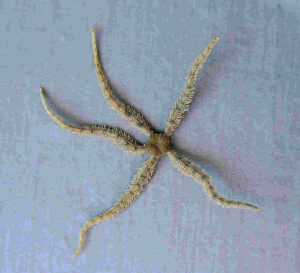Banded Brittle Star, Ophiocoma alexandri

 Banded Brittle Star, Ophiocoma alexandri. A very common brittle star collected from a tidal pool in the greater Los Cabos area, Baja California Sur, January 2016. Wing span: 15 cm (5.9 inches).
Banded Brittle Star, Ophiocoma alexandri. A very common brittle star collected from a tidal pool in the greater Los Cabos area, Baja California Sur, January 2016. Wing span: 15 cm (5.9 inches).
Phylogeny: The Banded Brittle Star, Ophiocoma alexandri (Lyman 1860), is a member of the Ophiocomidae Family of Brittle Stars. An informal name for this species is Alexander’s Spiny Brittle Star.
Distribution: They are benthic organisms, favoring rocky shores, under rocks, and in sand or muddy areas of the lower and intertidal zones at depths up to 70 m (230 feet). They are found throughout the Sea of Cortez, along the west coast of Baja California Sur, and along the coast of the mainland south to Guatemala. They are normally mixed in with the Black Spiny Brittle Star, Ophiocoma aethiops.
Morphology: This echinoderm has a rounded central disk with five lobes, rounded oral plates, within a maximum diameter of 2.5 cm (1.0 inch). Long slender arms stem out from in between the lobes and can reach a maximum length of 44 cm (17.5 inch). This organism typically has five arms, but this number can vary from four to six depending on stage of arm regeneration. The arms are gray with dark brown banding and five to seven stout, blunt spines on each lateral plate that are perpendicular to the arm axis. The aboral or dorsal surface of the disk has a uniform light brown coloration and is covered with minute granules giving it a sandpaper feel. The ventral side is a uniform color without banding. Their color can changes as the day progresses to various shades of black, brown, and gray.
Reproduction: The Banded Brittle Star reproduces via broadcast spawning. Fertilization occurs externally through the water, producing zygotes that develop into free-swimming pluteus larva. This results in distinct male and female sexes in equal numbers, known as gonochoric reproduction.
Diet: Their diet typically consists of detritus, small fish, mollusks, plankton, and worms.